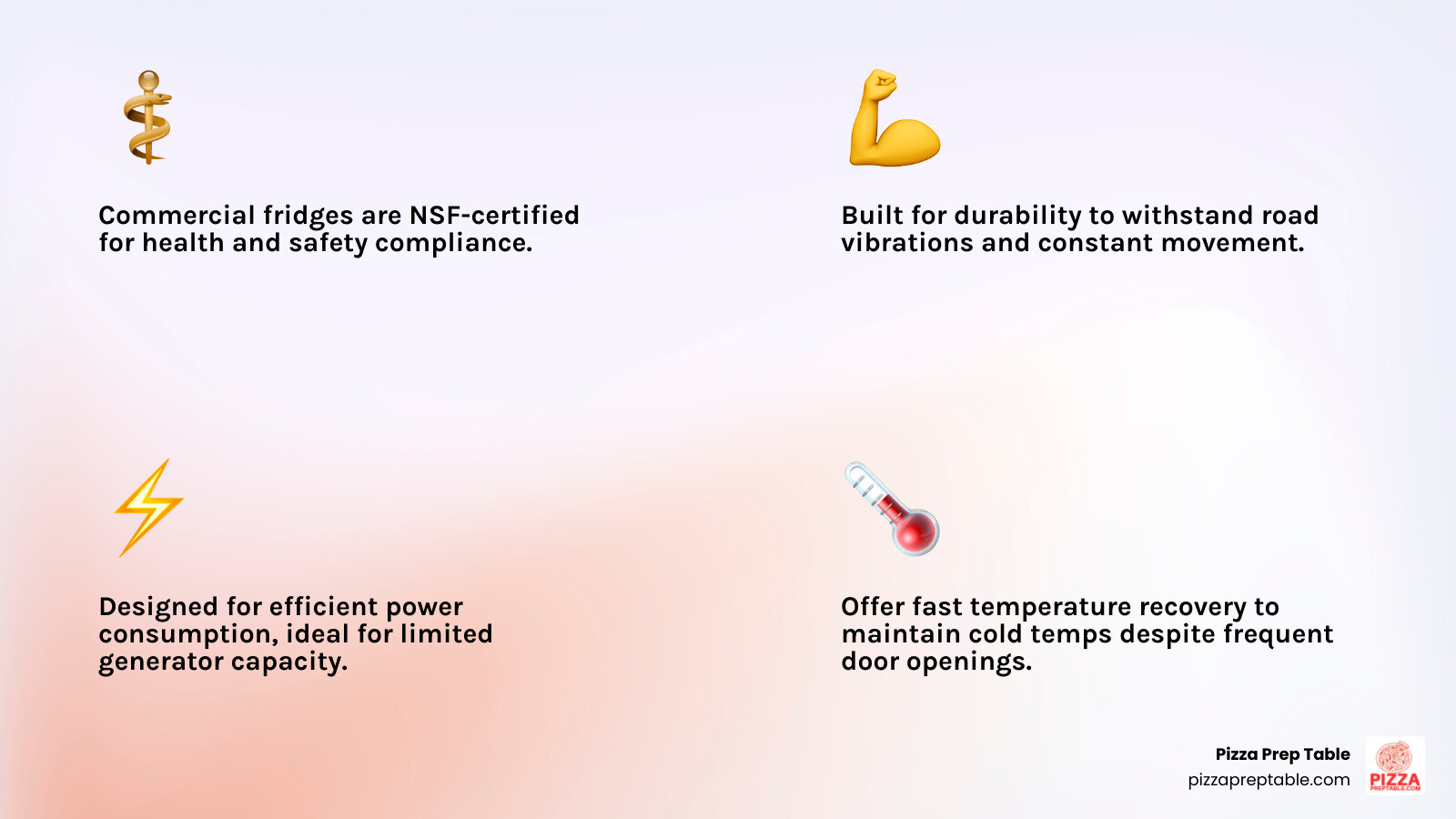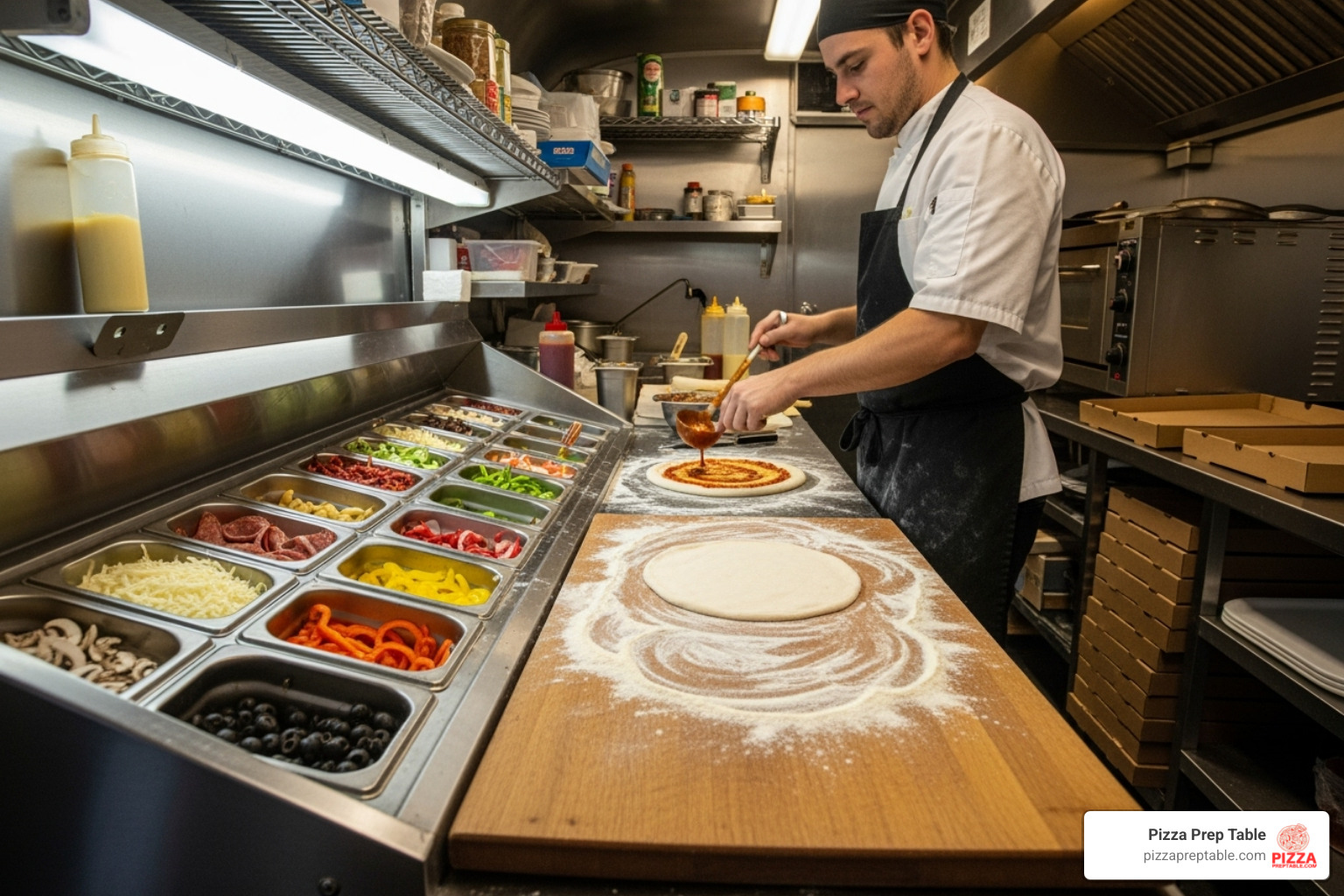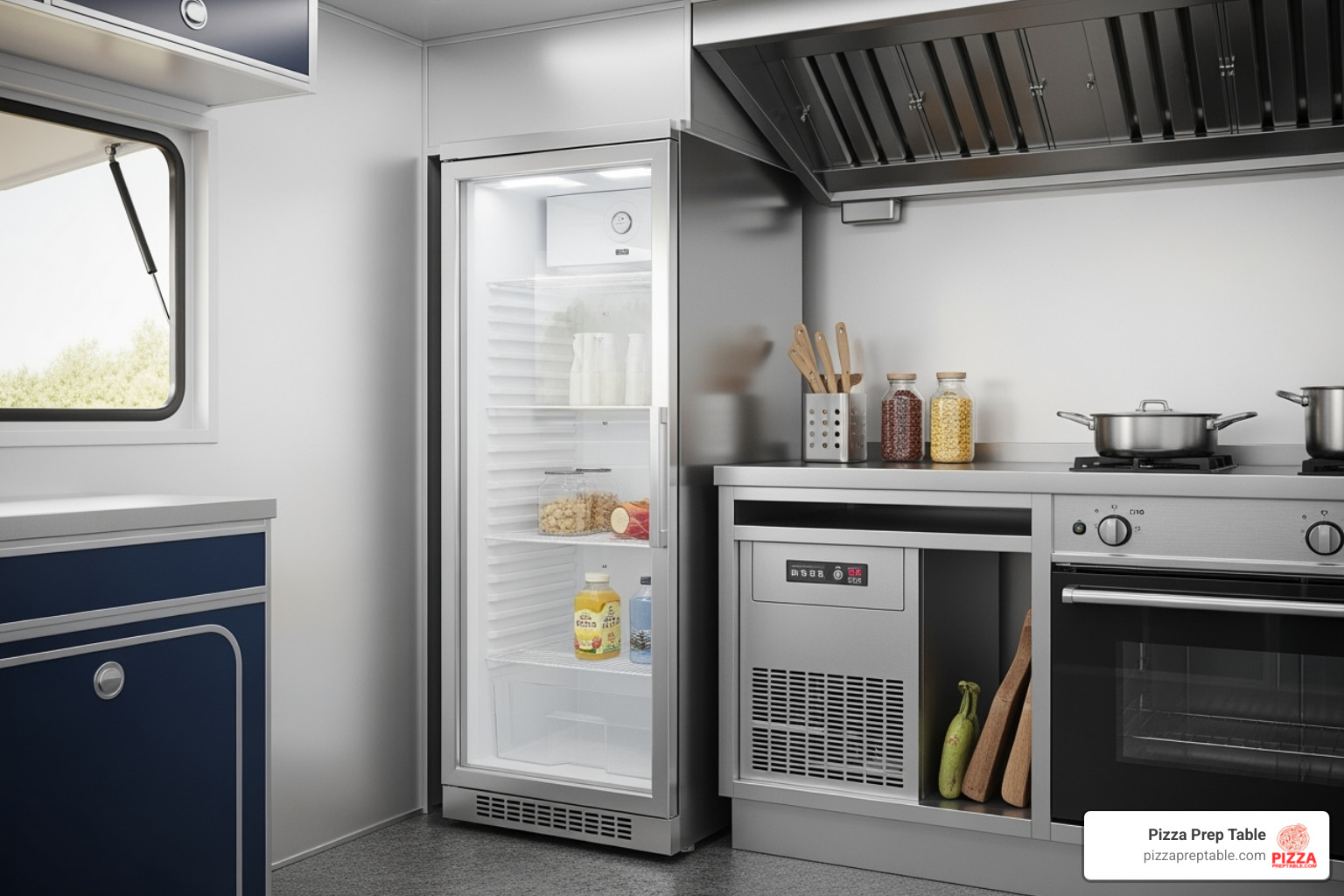Food Truck Fridges: Your Top Picks for Mobile Cooling
Share
Why the Right Food Truck Fridge Makes or Breaks Your Mobile Business
A food truck fridge is the backbone of any successful mobile kitchen. Without proper refrigeration, you can't maintain food safety, keep ingredients fresh, or meet the health code requirements that keep your business running legally.
Essential Food Truck Fridge Requirements:
- NSF-certified commercial grade - Required for health department approval
- Durable construction - Must withstand road vibrations and constant movement
- Efficient power consumption - Works with limited generator or battery capacity
- Space-optimized design - Maximizes storage in cramped quarters
- Fast temperature recovery - Maintains cold temps despite frequent door openings
Many commercial equipment warranties don't cover mobile use due to increased wear and tear, making the right choice critical from day one. As one industry expert noted, "No matter what your food concept is going to be, you'll probably need at least one refrigerator installed on your food truck or concession trailer."
Common food truck fridge types include:
- Undercounter refrigerators (space-saving)
- Sandwich/pizza prep tables (dual-function storage and workspace)
- Reach-in refrigerators (maximum vertical storage)
- Chest-style freezers (energy efficient for frozen items)
I'm Sean Kearney, and my background in restaurant equipment sales has taught me that the right food truck fridge can mean the difference between a thriving mobile business and costly failures. My experience helping operators choose commercial refrigeration has shown me which brands and features hold up to the demands of mobile kitchens.

Food truck fridge terminology:
Why Your Food Truck Needs a Commercial-Grade Fridge
Trying to cut corners with a residential fridge in a food truck often leads to wilting produce, warming meats, and a potential health code nightmare. Your food truck fridge faces challenges that no home refrigerator was designed to handle.
Every pothole and sharp turn creates vibrations that can damage the delicate components of a standard fridge. Commercial-grade refrigerators are built with reinforced frames, secured compressors, and heavy-duty parts that can take this punishment day after day.
Inside your truck, temperatures can soar from blazing grills and fryers. Commercial food truck fridges have powerful compressors and superior insulation to keep ingredients safely chilled, even when the ambient temperature is high.
Here's where it gets serious: NSF Certification isn't just a suggestion – it's a legal requirement. Health departments mandate NSF-certified equipment because it meets strict standards for food safety, easy cleaning, and consistent temperature control. You can learn more in our Food Safety Guidelines for Restaurants.
Faster temperature recovery is another key advantage. During a busy rush, a commercial unit snaps back to the proper temperature quickly after the door is opened, protecting your food and keeping you compliant.
Surprisingly, commercial fridges can be more energy efficient for food truck use. Their superior insulation and efficient compressors mean they work less to maintain temperature, reducing strain on your generator and lowering operating costs.
The bottom line: using a residential fridge is a risk you can't afford. A proper commercial-grade fridge isn't just equipment – it's insurance for your business, reputation, and peace of mind.
Key Factors for Choosing the Right Food Truck Fridge
Selecting the perfect food truck fridge requires careful planning. Getting these key factors right from the start saves you countless headaches down the road.

Size and footprint are critical. Every inch matters in a mobile kitchen. Measure your available space twice—height, width, and depth—and don't forget door clearance. A reach-in refrigerator is useless if you can't open the door without hitting other equipment. Many operators choose undercounter models designed for tight spaces.
Your capacity needs depend on your menu. A gourmet burger truck needs different storage than a hot dog cart. Consider daily needs and busy weekend festivals. However, overstuffing a food truck fridge hurts performance by blocking airflow, which can lead to temperature inconsistencies and food safety issues.
Let's talk power. You'll encounter two main options: 12V DC versus 110V AC systems. Most commercial units run on 110V AC, requiring a generator or a quality inverter system.
Generator requirements are crucial. A refrigerator's startup power draw can be 3-5 times its running watts. An 800-watt fridge might need a 3,000-watt generator capacity at startup. An undersized generator can lead to equipment damage.
Inverters convert your truck's 12V DC power to the 110V AC your fridge needs. Ensure your inverter can handle startup surges; it's better to oversize than risk equipment failure during a lunch rush.
Don't overlook ventilation. Commercial refrigerators generate heat that needs to escape. Cramming a unit into a tight space without proper airflow makes it work harder, use more power, and break down sooner. Plan for adequate clearance around condenser coils.
The door type decision is between solid and glass. Solid doors offer superior energy efficiency and temperature consistency, ideal for ingredient storage. Glass doors are great for merchandising drinks but are less efficient and require constant cleaning.
For a complete breakdown of budgeting for your mobile kitchen, check out Counting Your Fries Before They Hatch: Food Truck Kitchen Equipment Costs Explained.
Top Types of Refrigerators for Your Mobile Kitchen
In the tight confines of a food truck, every piece of equipment must be efficient. The commercial refrigeration industry has developed several solutions ideal for mobile kitchens. Understanding these popular food truck fridge types will help you make the smartest choice for your space and concept.
Undercounter Refrigerators

Undercounter refrigerators are masters of maximizing limited space. Instead of taking up vertical room, these units tuck neatly under prep counters, putting refrigerated storage right at your workstation.
They come in two main styles. Drawer models are excellent for organizing prepped vegetables, cheeses, and sauces. Door models offer more flexible storage for larger or oddly-shaped items.
Common sizes range from 27 to 72 inches wide, making it easy to find a fit for your truck's layout. These units are popular for their space-saving design and workflow efficiency.
Sandwich and Pizza Prep Tables

Sandwich and pizza prep tables are the Swiss Army knives of food truck fridges, combining refrigerated storage with a dedicated workspace. This dual-functionality is perfect for mobile kitchens.
The refrigerated base stores bulk ingredients, while the insulated top ingredient rail holds pans of prepped toppings at safe temperatures. Next to the rail is a spacious cutting board for assembly. This setup creates incredible workflow optimization, allowing staff to build orders without moving around the kitchen.
This efficiency is crucial during lunch rushes and festivals. For more ideas on organization, see our guide on Commercial Kitchen Storage Solutions. These prep tables are staples for mobile pizzerias and sandwich shops.
Reach-In Refrigerators

When you need serious cold storage without sacrificing floor space, reach-in refrigerators are the answer. These units champion vertical storage, offering maximum capacity in a small footprint.
While traditional reach-ins can be bulky, manufacturers offer slim models with single doors designed for tight spaces. They are perfect for storing bulk ingredients, beverages, or prepped items not needed on the immediate prep line.
The key consideration is height. Carefully measure your truck's interior, accounting for overhead shelves or ventilation. Models like the True Manufacturing T-19 are popular because they are built tough and sized appropriately for most food trucks. While not as accessible as undercounter units during service, they are essential for holding primary inventory.
Our Top Picks: The Best Food Truck Refrigerators
After years of working with food truck operators, I've seen which food truck fridge models survive the bumps, heat, and daily grind. These are battle-tested units that keep working when your business depends on it.
| Brand | Type | Capacity (Cu. Ft.) | Price Range (Approx.) |
|---|---|---|---|
| True Manufacturing | Undercounter, Reach-In, Prep Table | 5-27 | $1,800 - $4,500+ |
| Atosa | Undercounter, Prep Table | 7-15 | $1,200 - $3,000 |
| Dukers | Undercounter, Prep Table | 7-15 | $1,100 - $2,800 |
| Turbo Air | Undercounter, Prep Table, Reach-In | 7-27 | $1,500 - $4,000+ |
| Beverage Air | Undercounter, Prep Table, Reach-In | 7-27 | $1,400 - $4,000+ |
Note: Prices are estimates and can vary based on model, features, and supplier.
Best Overall: True Manufacturing Refrigerators
True Manufacturing units have earned their reputation as the gold standard for food truck fridges. What sets True apart is its warranty for mobile use. While most manufacturers void warranties in food trucks, True stands behind its products in mobile applications, offering valuable peace of mind.
The True T-19 model is legendary among operators for its durability and power efficiency. True's HC line (hydrocarbon refrigerant) is particularly impressive, significantly lowering power consumption. When running on a generator or battery, that efficiency is critical. At PizzaPrepTable.com, we've supplied countless True Pizza Prep Tables to mobile pizzerias with consistently positive feedback. The upfront cost is higher, but the reliability makes True a smart long-term investment.
Best Value Food Truck Fridge: Atosa & Dukers Models
For operators on a tighter budget, Atosa and Dukers models offer excellent value. These brands prove you don't have to sacrifice quality for a reasonably priced food truck fridge.
Atosa Undercounter units have a loyal following for their reliability and stainless steel construction, which holds up to daily wear. They offer solid, no-frills refrigeration that keeps ingredients safe. Dukers Prep Tables provide similar value, combining storage and workspace without a premium price tag. We've seen many successful trucks built around Dukers Pizza Prep Tables, with owners praising their affordability and performance. For new operators, Atosa and Dukers are smart buys.
Most Versatile Food Truck Fridge: Turbo Air Prep Tables
Turbo Air impresses with innovative features and thoughtful design. The standout feature is its self-cleaning condenser, which uses a rotating brush to automatically remove dust from the coils. This prevents the buildup that causes most refrigeration failures and is a huge benefit in a food truck environment.
Turbo Air Sandwich Prep Tables combine durability with user-friendly design, offering impressive temperature recovery and build quality. Their versatility extends across a range of models designed with the mobile kitchen in mind, offering reliability with features that make your job easier. For more insights on equipping your kitchen, check out Rolling Kitchens 101: What Equipment Does a Food Truck Need.
Installation & Maintenance Essentials
Your perfect food truck fridge is just the beginning. Proper installation and maintenance are key to its longevity and performance through thousands of miles and countless service rushes.
Securing the Unit
Your food truck fridge won't stay put on its own. Constant vibrations and sudden stops can turn an unsecured unit into a hazard. Straps are not enough; they stretch and loosen over time.
The best method is using heavy-duty angle brackets mounted securely to both the top and bottom of the refrigerator. These create a rigid connection that won't budge. The critical part is to avoid the freon lines when drilling or screwing brackets into place. Puncturing a refrigerant line means an expensive repair and spoiled food. If you're not 100% confident, hire a professional.
Proper Ventilation
Refrigerators generate significant heat as they work. Adequate clearance around your food truck fridge is essential, not optional. The condenser coils need several inches of space on the sides and back to release heat effectively.
Poor ventilation forces the unit to work overtime, leading to higher energy consumption, increased wear on components, and a shorter lifespan. In a food truck's tight confines, planning for airflow is critical.
Maintenance Tips
Regular maintenance separates successful operators from those constantly dealing with breakdowns.
Clean condenser coils monthly. These coils collect dust and grease, forcing your food truck fridge to work harder. Use a stiff brush or vacuum. Some newer models feature self-cleaning condensers, a real game-changer for busy operators.
Check door seals regularly. Look for cracks or tears in the rubber gaskets. A worn seal wastes energy and compromises food safety. Test it by closing the door on a dollar bill; if you can pull it out easily, the seal needs attention.
Monitor temperature with an independent thermometer to verify that your fridge is consistently below 40°F. This protects your customers and your reputation.
Taking these steps seriously will keep your refrigeration running reliably for years.
Frequently Asked Questions about Food Truck Fridges
Running a food truck comes with unique challenges, and refrigeration questions are common. Here are the answers to the questions we hear most often.
What size refrigerator do I need for my food truck?
There's no one-size-fits-all answer. The perfect food truck fridge size depends on a few key factors:
- Your Menu: A simple menu requires less cold storage than one with many fresh toppings. Your prep process also matters; daily fresh prep requires different capacity than batch prep.
- Restocking Schedule: If you restock daily, you can use a smaller unit. For multi-day festivals where you can't leave, you'll need significantly more capacity.
- Available Space: This is often the biggest limitation. Measure your truck's available space first, as it will dictate your options.
- Workflow: Sometimes two smaller undercounter fridges are more efficient than one large reach-in that blocks movement. Consider who needs access to what and when.
Our advice: map out your menu and prep process, then measure your truck. Getting this puzzle right makes everything else easier.
Can I use a home refrigerator in my food truck?
The answer is a firm no. We've seen operators try this shortcut, and it always ends poorly for several reasons:
- Health Codes: Health departments require NSF-certified commercial equipment. A residential fridge will not pass inspection.
- Durability: Home fridges are not built to withstand the constant vibrations of the road. Components will fail quickly.
- Performance: Residential units cannot maintain safe temperatures in the high ambient heat of a food truck kitchen, leading to spoiled food and safety risks.
- Warranty: Any residential warranty is voided the moment you install the unit for commercial use in a vehicle.
The initial savings are not worth the cost of failed inspections, spoiled food, and emergency replacements. A commercial food truck fridge is a necessary investment in your business.
How much do food truck refrigerators cost?
Budgeting for refrigeration is a crucial part of your startup plan. Food truck fridge prices typically range from $1,100 to over $4,500, depending on the type, size, and brand.
- Budget-Friendly ($1,100 - $1,500): This range includes basic undercounter units from brands like Atosa or Dukers. They are no-frills but will pass health inspections and keep food cold.
- Mid-Range ($1,500 - $3,000): Here you'll find solid prep tables, larger undercounter models, and some reach-in refrigerators. Most food trucks operate comfortably with equipment in this price range.
- Premium ($3,000+): This includes large, feature-rich prep tables and high-end units from manufacturers like True. These often come with better energy efficiency and mobile-use warranties.
Remember to factor in installation costs. Investing in a reliable unit upfront often saves money in the long run on repairs and energy bills.
Conclusion
Choosing the right food truck fridge is about building a foundation for a successful mobile business. It's your insurance against road vibrations, summer heat, and demanding health inspections.
NSF certification is non-negotiable; it's your ticket to operating legally. When selecting a unit, the key factors of size, power, and ventilation will guide you to the best choice, whether it's a space-saving undercounter model, an efficient prep table, or a high-capacity reach-in.
Our top picks—from the reliability of True Manufacturing to the value of Atosa and Dukers, and the innovation of Turbo Air—are battle-tested workhorses. The job isn't done after purchase; proper installation and regular maintenance are essential for a long service life.
Your food truck fridge is a silent partner, preserving food quality and maintaining safety standards so you can focus on creating amazing food. It's a critical investment in your operational efficiency and profitability.
At PizzaPrepTable.com, we've helped countless operators find the right refrigeration for their unique needs. We understand that every decision matters when space is limited and stakes are high.
Ready to take the next step? Explore our full range of Pizza Prep Tables and find how the right equipment can transform your mobile kitchen into a profitable machine ready for the road ahead.
